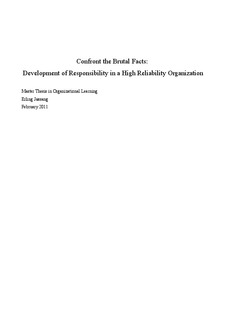| dc.description.abstract | In 2004, Trondheim and Bodø Air Traffic Control Centres merged, as part of a strategic change program following the logic inherent in New Public Management. After a while, personnel conflicts led to a shortage of staff that cost Avinor in many different ways.
Due to emotional outbursts in different forms when talking about the events on both sides even in 2010, I suspected that Avinor had not taken the opportunity to learn from the event. Thus, I found it important to find out what was causing this organizational infection.
By gathering different individual stories through unstructured interviews, it became clear that the opinions regarding the source of the conflict level were so different that these differences became the main focus of analysis. As detailed information was available only from one side, it seemed impossible to find out what the truth was, so I stopped looking for it. Instead, I focused on the individual perceptions, and put them together in a “collective, subjective story” from both sides.
I invited quite a few people to comment on the stories, and a fuller picture emerged. I put the information together, and created images of different situations from the interviews, the stories, and the additional information. What had happened became unreal to me, until the work of Stanley Milgram snapped into my head after reading a comment from an informant for the hundredth time.
Looking at the events both in light of the human tendency to obey authorities and the human tendency to explore and excel in what we do provided insight enough to understand that this could be explained by theory on adult development – or constructivist-developmental theory. In light of this, the different perspectives and events became possible to understand.
What emerged was the insight that the process has probably become what Richard Sennett calls salutary failure for one side of the merger. For the other side, the process seems to have become an abscess, one that is not to be touched. A part of the conclusion is that this should be done for their own sake, the other part is that Avinor has still much to learn from this.
The implications from this project is that Avinor should work on the organization’s shared understanding of safety, include a broad image of the ATCO as a craftsman in training, facilitate leadership development, and consider how to make the organization more resilient to the wrong people holding positions. | nb_NO |
